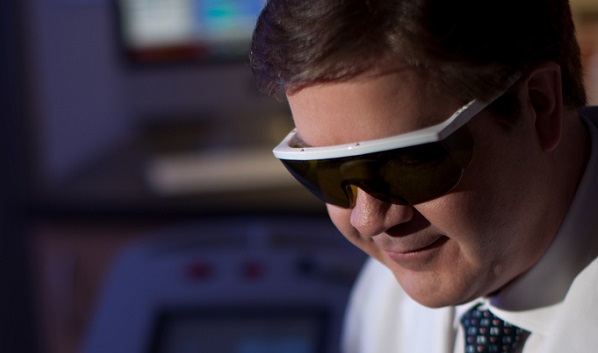Pharmaceutical companies want to do everything they can to get you and your children to take the jab. With campaigns launched which are mostly based on fear-mongering us into vaccinations, you’d think ideas to persuade vaccination pushes would be thin otherwise. But that’s not true at all. Not even close. That’s because vaccine makers believe another big reason which vaccines aren’t digestible to human psyche is that they are disseminated using hypodermic needles. And now a Chinese Professor is looking to solve this issue for them by replacing vaccines with patches.
University of Rhode Island researcher Xinyuan Chen envisions a day when shots are a thing of the past. In fact, he’s been working on an alternative.
Inside his laboratory, he displays a small vial of white powder that could potentially contain vaccine and then uses tweezers to grab and hold up a tiny square object made of contact lens material. On close inspection, it’s apparent that it contains an array of white dots.
“The white dots are the powder,” says Chen, noting that it is an antigen widely used in immunization research. “It’s only 1 to 5 microns in diameter.”
So how would the powderized vaccine be administered? That’s where things get even more interesting.
Much like conventional drug-treatment patches, but smaller and thicker, Chen’s would be applied to the skin, but with a twist: Before applying the patch, the skin would be perforated by a laser.
Yep, you read that correctly, the new way of getting a vaccine into a crying child would be using a laser. This is supposed to relieve us of the side effects, such as soreness and bruising at the spot of the needle shot. It is supposed to relieve the mental anguish of children who see a needle. It is supposed to be a more palatable way to take a shot.
But here is what they fail to solve: It is still a vaccine, no matter how the vaccine is placed inside the baby’s body. To be honest, this concept wildly overlooks why the vast majority of parents choose to not vaccinate an infant or child. They do so based on logical health reasons. I’ve hardly ever had a parent tell me that their infant’s fear of needles drove them to pass on a vaccination. This is pharmaceutical detachment. This is attempting to make something seem like an advancement for the betterment of society when really it is just a pig in a dress.
The pitch is “no pain will be felt.” But when will the pitch be “no side effects will ever happen.” Or, “pharmaceutical companies will be held accountable for vaccine injuries.” Lasers and patches are detached philosophically from the actual issues of concern. It would be great if needles were the core issue and dilemma. But that is unfortunately not the issue among us. In fact, when reading the fine print on these laser delivery systems, they could make the vaccine worse by delivering more adjuvants throughout the child’s body.
Much of Chen’s research into the laser-patch delivery system has focused on how to improve the effectiveness of vaccines — and eliminate their side effects — through adjuvants. Adjuvants are substances commonly added to vaccines to boost the body’s immune response.
While a shot delivers vaccine and adjuvants all at once and in one precise location, a patch can diffuse the delivery over a larger area and a longer period of time, Chen says.
You thought they were helping to quell children’s fears of needles, but instead, they merely found a way to make the shot potentially more toxic. And what about lasers on the skin of an infant? Shall we even go there? The future of vaccines, once again, proves itself to be more corrupt than philanthropic, as per usual.
Photo by Vancouver Laser & Skincare Centre 


